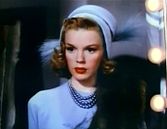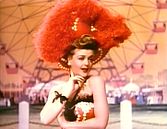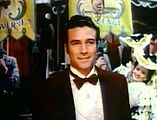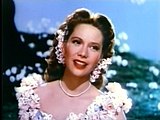Till the Clouds Roll By
| Till The Clouds Roll By | |
|---|---|
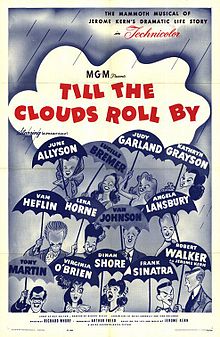 Theatrical release poster | |
| Directed by | Richard Whorf uncredited
|
| Screenplay by | Myles Connolly Jean Holloway George Wells(adaptation) Uncredited:[2] Fred Finklehoffe John Lee Mahin Lemuel Ayers Hans Willheim |
| Story by | Guy Bolton |
| Produced by | Arthur Freed |
| Starring | |
| Cinematography | George J. Folsey Harry Stradling |
| Edited by | Albert Akst |
| Music by | Music: Jerome Kern Lyrics:[3]
|
Production company | |
| Distributed by | Loew's, Inc. |
Release date |
|
Running time | 132 min. |
| Country | United States |
| Language | English |
| Budget | $3,316,000[4] |
| Box office | $6,724,000[4] |
Till The Clouds Roll Byis a 1946 AmericanTechnicolormusical film produced byMetro-Goldwyn-Mayerand a fictionalized biopic of composerJerome Kern,portrayed byRobert Walker.Kern was involved with the production, but died before its completion. It was the first in a series of MGM biopics about Broadway composers.[1]
The film is one of the MGM musicals that entered thepublic domainwhen MGM failed to renew its copyright.[5]
Plot
[edit]Kern attends the opening night ofShow Boatin 1927, the landmark musical that secured his popularity. Following several of the show's most notable songs, Kern departs to reminisce about his early days as a young songwriter.
Kern recounts meeting Jim Hessler, a musical mentor, and Hessler's young daughter Sally. Kern and the Hesslers grow close, and he later visits them in London. Taking Sally to the fair inspires Kern to conceive a stage production for one of his songs. At theLondon Gaietiesrevue, Kern's song garners the attention of theatrical producerCharles Frohman.
When Kern happens to meet Eva Leale, it's love at first sight, but the courtship is cut short. He must abruptly sail back to New York to adaptThe Girl from Utahfor its Broadway debut. Following the show's success, Kern narrowly misses sailing back to London on theRMSLusitania.
The 1917 opening night ofOh, Boy!includes the musical number "Till the Clouds Roll By". The composer proposes to Eva and returns to New York to continue his string of theatrical successes, includingLeave It to Jane.His 1920 musicalSally,starringMarilyn Miller,popularized the song "Look for the Silver Lining".
Now grown up, Sally Hessler asks her Uncle Jerry to help her get a stage role. He writes the song"Who?"for her to have a part in the 1925 musicalSunny.After the show's producers give the song to star Marilyn Miller, Sally leaves in protest. At the opening night ofSunny,Kern learns that Sally has run off, leaving her father despondent.
All attempts to locate Sally fail and Jim Hessler dies, leaving a mourning Kern unable to work.Oscar Hammersteinvisits the Kerns to share a copy of the1926 novelShow Boat.The same night, Kern learns that Sally will be performing at a club in Memphis, Tennessee. He leaves to find her and they make amends; he then spends the night listening to the sounds of the Mississippi River.
Having recounted his life story so far, Kern feels his career has likely come to a conclusion withShow Boat.On the contrary, he continues to write hit shows, includingThe Cat and the Fiddle(1931) andRoberta(1933). While visiting a sound stage at MGM, Kern is delighted to discover that the studio has cast Sally to perform in a new film featuring his songs.
The film concludes with highlights of Kern's Hollywood career, including songs fromSwing Time(1936),Cover Girl(1944), andBroadway Rhythm(1944); the montage ends with songs fromSweet AdelineandShow Boat.
Cast
[edit]- Robert WalkerasJerome Kern
- June Allysonas herself/Jane inLeave It to Jane
- Lucille Bremeras Sally Hessler (fictional)
- Judy GarlandasMarilyn Miller
- Kathryn Graysonas Magnolia Hawks inShow Boat/Herself
- Van Heflinas James I. Hessler, Kern’s (fictional) mentor
- Lena Horneas Julie LaVerne inShow Boat/Herself
- Dorothy Patrickas Eva Kern
- Van Johnsonas bandleader in Elite Club
- Tony Martinas Gaylord Ravenal inShow Boat/Himself
- Dinah Shoreas Julia Sanderson
- Frank Sinatraas himself
- Gower Championas specialty dancer inRoberta
- Cyd Charisseas specialty dancer inRoberta
- Angela Lansburyas London specialty
- Ray McDonaldas dance specialty inOh, Boy!andLeave It to Jane
- Virginia O'Brienas Ellie Mae inShow Boat/Herself
- Mary Nashas Mrs. Muller
- Joan Wells as Young Sally Hessler
- Harry HaydenasCharles Frohman
- Paul LangtonasOscar Hammerstein II
- Paul MaxeyasVictor Herbert
Cast notes
- Esther Williamsmakes a cameo.
- Sally ForrestandMary Hatchermake appearances as "chorus girls".[2]
- Kathryn Graysonreprised the role of Magnolia Hawks in MGM's film adaptation ofShow Boat,released in 1951.[2]
Production
[edit]
The working title for the film was "As the Clouds Roll By".[2]Gene Kellywas intended to play Kern, withGloria DeHaven,Jacqueline White,Imogen Carpenter,andJeanette MacDonaldin major parts. None appeared in the film.[2]
When the film started production in the fall of 1945,Judy Garlandwas signed as Broadway singer-dancerMarilyn Miller,having just returned to California after a long New York honeymoon with her new husband, directorVincente Minnelli.[1]Soon after, Kern returned to New York toward the end of October and died in November 1945.
During the six months that it took to shoot the film, producerArthur Freedhad to find one director after another.Lemuel Ayers,a set designer, was scheduled to make his directorial debut on the film, but was replaced byBusby Berkeleylate in August 1945. Meanwhile, Minnelli – who, it was rumored at the time, would be taking over the direction of the film – was shooting Garland's sequences even before the beginning of principal photography as she was pregnant and expected to give birth in March 1946; her shooting was completed on November 8, 1945. By the time full shooting began in the middle of December, Berkeley had been replaced byHenry Koster,who then was replaced after a short period byRichard Whorf.Whorf received the onscreen directorial credit.[1][2]There was a break in production from some time in January 1946 to the middle of March of the same year.[2]
The film includes two versions of "Ol' Man River": the first sung by Caleb Peterson and an African-American chorus as part of theShow Boatmedley, and the second, a "crooner version" byFrank Sinatra,featured as the grand finale.
Barbetteconsulted on the creation of the film's circus sequence.[6]
Songs
[edit]- "Cotton Blossom" - MGM Studio Orchestra and Chorus
- "Where's the Mate for Me" - Tony Martin
- "Make Believe"- Kathryn Grayson/Tony Martin
- "Life Upon the Wicked Stage" - Virginia O'Brien/MGM Studio Orchestra and Chorus Girls
- "Can't Help Lovin' Dat Man"- Lena Horne
- "Ol' Man River"- Caleb Peterson/MGM Studio Orchestra and Chorus
- "Ka-Lu-a" - MGM Studio Orchestra
- "How'd You Like to Spoon with Me" - Angela Lansbury/MGM Studio Orchestra and Chorus
- "They Didn't Believe Me"- Dinah Shore
- "Till the Clouds Roll By" - June Allyson/Ray McDonald/MGM Studio Orchestra and Chorus
- "Leave It to Jane" - MGM Studio Orchestra and Chorus/June Allyson/Ray McDonald
- "Cleopatterer" - June Allyson/Ray McDonald/MGM Studio Orchestra and Chorus
- "Leave It to Jane" (Reprise) - MGM Studio Orchestra and Chorus/June Allyson/Ray McDonald
- "Look for the Silver Lining"-Judy Garland
- "Sunny"- Judy Garland/MGM Studio Orchestra and Chorus
- "Who?"- Judy Garland/MGM Studio Orchestra and Chorus
- "One More Dance" -Lucille Bremer(Dubbed byTrudy Erwin)
- "I Won't Dance"-Van Johnson/Lucille Bremer (dubbed by Trudy Erwin)
- "She Didn't Say Yes"-Lee and Lyn Wilde,aka "The Wilde Twins"
- "Smoke Gets in Your Eyes"-Cyd Charisse/Gower Champion
- "The Last Time I Saw Paris"-Dinah Shore
- "The Land Where the Good Songs Go" - Lucille Bremer (dubbed by Trudy Erwin)
- "Yesterdays"- MGM Studio Orchestra and Chorus
- "Long Ago (and Far Away)"-Kathryn Grayson
- "A Fine Romance"-Virginia O'Brien
- "All the Things You Are"-Tony Martin
- "Why Was I Born?"-Lena Horne
- "Ol' Man River" (Reprise/Finale) -Frank Sinatra/MGM Studio Orchestra and Chorus
Surviving Judy Garland outtake
[edit]A video of an excised musical number survives from this film, but part of the soundtrack has been lost. Judy Garland, as Marilyn Miller, sings "D'Ya Love Me?" to two clowns in a circus setting, representing a scene from the Broadway musicalSunny.[7]The clowns are played by Swedish clowns Jean and Rene Arnaut, known as the Arnaut Brothers. Although uncredited, they appear in the edited movie in the walk-around at the start of theSunnycircus.
Soundtrack album
[edit]


The film was one of the early movies to have a soundtrack album released concurrently with it arriving in theaters. The soundtrack was produced by MGM Records, originally released as four 78-rpm records featuring various artists and songs from the film and cover artwork byLennie Hayton.The album was released on LP.[8]No official authorized version has yet been released on CD, but several unauthorized versions have appeared on the market.Rhino Entertainmentcurrently owns the rights to issue an authorized CD of the soundtrack under license fromTurner Entertainment;in the past,MCA RecordsandSony Music Entertainmentheld such rights.[citation needed]
Reception
[edit]Critical response
[edit]Bosley Crowther,reviewing the film forThe New York Times,wrote:[9]
"Why didMetro...have to cook up a thoroughly phoney yarn about the struggles of a chirpy young composer to carry the lovely songs ofJerry Kern?And why did it have to do it in such a hackneyed and sentimental way as to grate on the sensibilities of even the most affectionately disposed? "
Varietydiffered, opening its satisfactory notice with "Why quibble about the story?" and likening the film to another such venture, Cary Grant'sNight and Day.[10]In a retrospective review, American film criticPauline Kaelwrote, "This monster thing, spawned at M-G-M, was meant to be the life of Jerome Kern."[11]
Box office
[edit]The film earned $4,748,000 in the U.S. and Canada box offices and $1,976,000 in other markets, but because of its high cost, the profit was $732,000.[4][12]
Accolades
[edit]The film is recognized byAmerican Film Institutein these lists:
- 2006:AFI's Greatest Movie Musicals– Nominated[13]
Home media
[edit]The film is one of several MGM musicals – another beingRoyal Wedding– thatentered the public domain28 years after production because the studio did not renew the copyright registration.[5]As such, it is one of the more widely circulated MGM musicals on home video.Warner Home Videogave it its first fully restored DVD release on April 25, 2006.
Related films
[edit]Till The Clouds Roll Bywas the first in a series of MGM biopics about Broadway composers: It was followed byWords and MusicaboutRodgers and Hartin 1948,Three Little WordsaboutKalmar and Rubyin 1950, andDeep in My HeartaboutSigmund Rombergin 1954.[1]
References
[edit]- ^abcdefLevy, Emanuel(2007)."Till the Clouds Roll By".EmanuelLevy.com.Retrieved2015-03-22.
- ^abcdefghiTill the Clouds Roll Byat theAFI Catalog of Feature Films
- ^"Music"TCM.com
- ^abcThe Eddie Mannix Ledger,Los Angeles: Margaret Herrick Library, Center for Motion Picture Study.
- ^abPierce, David (June 2007). "Forgotten Faces: Why Some of Our Cinema Heritage Is Part of the Public Domain".Film History: An International Journal.19(2): 125–43.doi:10.2979/FIL.2007.19.2.125.ISSN0892-2160.JSTOR25165419.OCLC15122313.S2CID191633078.
- ^Thompson, Karen R (2007-04-07).""Barbette": He started in the circus ".Community Impact newspaper.Archived fromthe originalon 2013-02-08.Retrieved2012-08-09.
- ^Judy Garland in outtake fromTill the Clouds Roll By(1946); soundtrack partially missingon YouTube
- ^"Trivia"TCM.com
- ^Crowther, Bosley(December 6, 1946)."'Till Clouds Roll By,' Musical Biography of Life of Jerome Kern With Robert Walker in Title Role, at the Music Hall ".The New York Times.Retrieved2015-03-22.
- ^Staff (December 31, 1945)."Review: 'Till the Clouds Roll by'".Variety.Retrieved2015-03-22.
- ^Kael, Pauline(1991).5001 Nights at the Movies.New York City: Picador. p. 772.ISBN978-0-8050-1367-2.Retrieved13 July2021.
- ^"Top Grossers of 1947",Variety,7 January 1948 p 63
- ^"AFI's Greatest Movie Musicals Nominees"(PDF).Retrieved2016-08-13.
External links
[edit]- "Till The Clouds Roll By"Full movie at BuggZugg YouTube
- Till the Clouds Roll Byat theAFI Catalog of Feature Films
- Till the Clouds Roll ByatIMDb
- Till the Clouds Roll ByatRotten Tomatoes(100%)
- Till the Clouds Roll Byat theTCM Movie Database
- Till the Clouds Roll ByatAllMovie
- Till the Clouds Roll Byis available for free viewing and download at theInternet Archive
- "Till The Clouds Roll By"at TheJudyRoom.com
- 1946 films
- 1940s biographical films
- 1946 musical films
- American biographical films
- American musical films
- 1940s English-language films
- Films about composers
- Films about musical theatre
- Films directed by Richard Whorf
- Films produced by Arthur Freed
- Films scored by Lennie Hayton
- Jukebox musical films
- Metro-Goldwyn-Mayer films
- 1940s American films
- English-language biographical films

